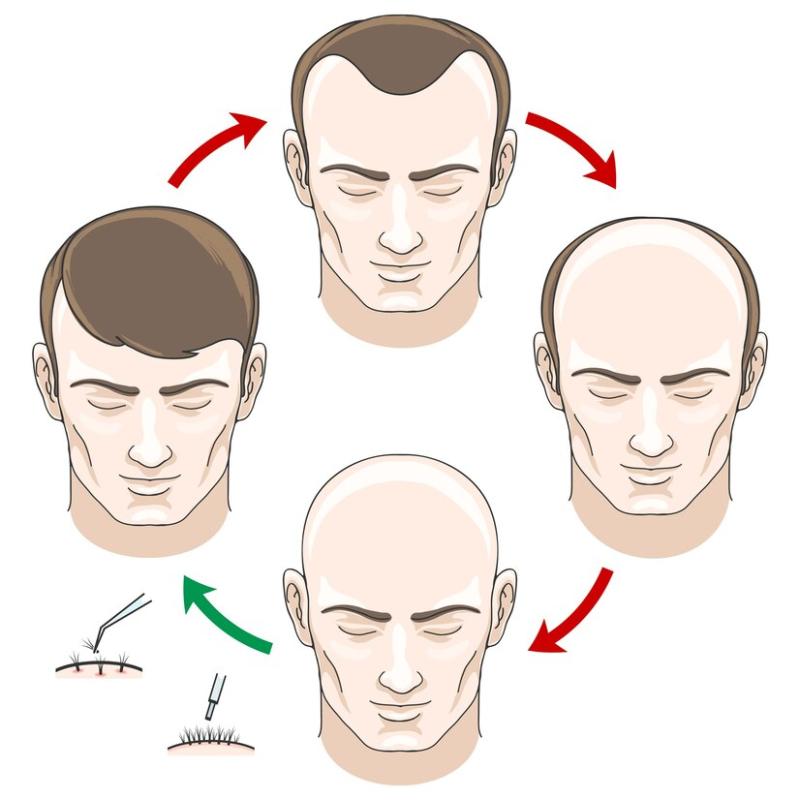The Ideal Hair Transplant Timeline: What to Expect Before, During, and After

Deciding to get a hair transplant is a significant step toward restoring your hair and confidence. However, many prospective patients are unsure of what the entire process looks like. From the initial consultation to the final results, a hair transplant journey is a multi-stage process that requires patience and understanding.
In this article, we'll break down the ideal timeline for a hair transplant, highlighting key milestones before, during, and after the procedure, so you know exactly what to expect.
Before the Hair Transplant: Preparing for Surgery
Initial Consultation (2–3 Months Before Surgery)
The first step in your hair transplant journey is meeting with a qualified hair restoration surgeon. During this consultation, your doctor will assess the extent of your hair loss, determine the cause, and discuss the best treatment plan for your individual needs.
Key points covered in the consultation include:Hair loss diagnosis (e.g., androgenetic alopecia or other causes)
Donor hair assessment (the sides and back of the scalp where hair is typically harvested)
Choosing the right procedure (FUE vs. FUT)
Cost estimation and financing options
At this stage, it's important to ask questions about the procedure, potential risks, and expected results. This consultation also gives you an opportunity to understand how your hair loss may progress and whether a hair transplant is the best option for you.
Pre-Surgery Instructions (1–2 Weeks Before Surgery)
In the weeks leading up to your surgery, your surgeon will give you pre-surgery instructions to ensure the best results. These may include:Avoiding certain medications (like aspirin or blood thinners)
Refraining from alcohol and smoking, which can impair healing
Washing your hair properly the day before surgery using a gentle, surgeon-recommended shampoo
You may also be asked to arrange transportation home on the day of the procedure since sedation may be used during the transplant.
During the Hair Transplant: The Surgery Day
Day of Surgery
The hair transplant procedure itself usually takes several hours, depending on the size of the area being treated and the technique used (FUE or FUT). Here’s what happens on the day of your transplant:
Preparation and Anesthesia:
You'll arrive at the clinic, and the surgical team will prepare your scalp. A local anesthetic will be administered to numb both the donor area (usually the back of the head) and the recipient area (the balding or thinning regions). This ensures that the procedure is painless.Donor Hair Extraction:
Depending on whether you’ve chosen Follicular Unit Extraction (FUE) or Follicular Unit Transplantation (FUT), the surgeon will harvest healthy hair follicles from the donor area. FUE involves removing individual follicles, while FUT removes a small strip of skin from which follicles are extracted.Recipient Site Preparation and Transplantation:
Once the donor hairs are prepared, the surgeon will create tiny incisions in the recipient area where the follicles will be implanted. The placement of each follicle is crucial for achieving a natural-looking hairline, so this part of the process requires meticulous attention to detail.Duration of Surgery:
The procedure can take anywhere from 4 to 8 hours depending on the extent of the transplant. After the surgery, you can go home the same day.
After the Hair Transplant: Recovery and Results
Immediate Post-Surgery (Day 1–7)
After the transplant, you’ll need to take extra care of your scalp during the initial healing period.Rest and Recovery:
For the first few days after surgery, you'll need to rest and avoid strenuous activity to help your scalp heal. Mild discomfort, swelling, and redness are normal and can be managed with prescribed medication.Washing Your Hair:
Your surgeon will provide specific instructions for gently washing your hair. Typically, you'll need to avoid washing for the first 48 hours and then follow a special washing routine for the next week to avoid damaging the grafts.Scabbing and Shedding:
Small scabs will form around each transplanted follicle within the first week. These will fall off naturally. It’s also common to experience "shock loss," where the transplanted hair sheds within the first 2–3 weeks. Don’t worry—this is a normal part of the process, and new growth will soon follow.Early Growth Stage (Month 1–3)
The first few months after surgery can be a test of patience, as visible results take time. By month 1:Shedding:
Most of the transplanted hair will shed (if it hasn’t already), leaving your scalp looking similar to its pre-transplant state.New Growth Begins:
Around 3 months post-surgery, you'll begin to notice new hair growth. The hairs that emerge will initially be fine and thin, but they will gradually thicken and strengthen over time.Significant Hair Growth (Month 4–6)
By month 4, you should start to see more visible growth. Your hair will become noticeably denser, and the hairline will begin to take shape. At this stage:Hair Texture and Thickness Improve:
The transplanted hair will start to blend with your natural hair, and any initial shedding will be a thing of the past.Continued Patience:
While the results are becoming more evident, it’s important to remember that full results won’t be visible just yet.Full Results (Month 9–12 and Beyond)
By the 9-month mark, you’ll see the most dramatic results of your hair transplant. Full results are typically visible after 12 months, and for some patients, continued growth and improvement can occur up to 18 months post-surgery.Final Hair Density:
The transplanted hair will now have fully grown in, giving you a natural-looking, fuller head of hair.Hair Styling and Maintenance:
Once your new hair has fully grown, you can treat it like your natural hair. You’ll be able to cut, color, and style it however you wish.
Long-Term Maintenance: Keeping Your Hair Healthy
While the transplanted hair is designed to last a lifetime, taking care of your hair and scalp is essential for maintaining your results long-term. Here are some tips for maintaining your hair after surgery:
Follow a healthy diet rich in vitamins and nutrients that promote hair health.
Use gentle hair products that don’t damage or dry out your hair and scalp.
Consider ongoing treatments like finasteride or minoxidil to prevent future hair loss in untreated areas.
Visit your hair specialist for periodic check-ups to monitor your hair health and growth.
Conclusion: Patience and Commitment Yield Lasting Results
A hair transplant is a long-term investment in your appearance and confidence. While the process requires patience, especially in the months following the procedure, the results can be transformative. Understanding the timeline—from the initial consultation to full results—can help you set realistic expectations and ensure you’re prepared for every stage of your hair transplant journey.
With proper care and maintenance, you can enjoy the results of your hair transplant for years to come.










Comments